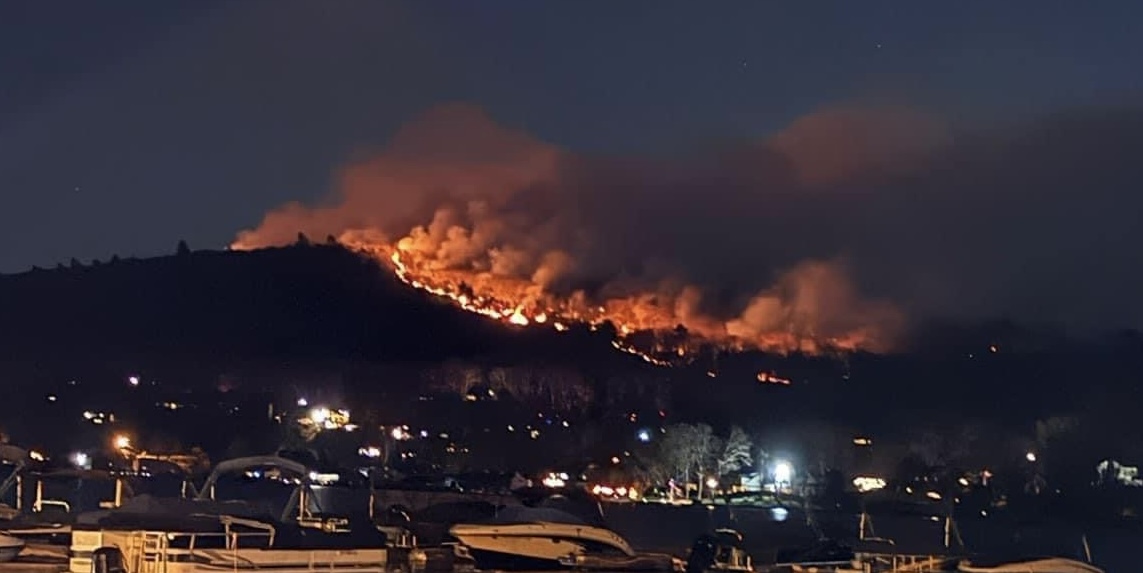
Greenwood Lake, NY – Orange County NY Executive Steve Neuhaus declared a State of Emergency yesterday, effective at 5 p.m. on Wednesday, November 13. The fire, which has ravaged areas near Greenwood Lake for over a week, remains active along the New York-New Jersey border, presenting substantial challenges to containment efforts as dry conditions fuel its spread. At the present time, weather conditions have kept the fire from spreading any further toward Rockland County.

Neuhaus’ declaration aims to streamline emergency response, allowing for rapid action by circumventing the competitive bidding process for resources essential to fight the fire. The fire, widley reported to have originated in Jennings Creek, has intensified due to unseasonably dry conditions across the region. Emergency service teams, including local fire departments, the New York State Department of Environmental Conservation (NYS DEC), and federal agencies, are engaged in a robust firefighting operation that involves controlled burns, aerial water drops, and the establishment of fire lines to prevent further spread into populated areas.
“We urge all residents to remain calm,” said Neuhaus in a public statement. “This declaration is a necessary step to grant emergency personnel the access and resources needed to manage the fire. The coordinated response by state, county, and local authorities continues to be our priority, and I want to thank the first responders tirelessly working to protect the community.”
In addition to NYS agencies and Orange County resources, all five Towns of Rockland have jumped in on the effort to contain the wildfire, which has already consumed more than 5000 acres of forest in the Greenwood Lake area. The Stony Point Wayne Hose Fire Department announced last night on social media that they sent a crew to aid in the containment effort.

Emergency Measures and Closures
As part of the emergency measures, Neuhaus’ executive order closed East Shore Road from 32 Edgemere Avenue to the north entrance of Woods Road, restricting both car and pedestrian access. This closure grants firefighters unimpeded access to perform critical fire suppression activities in hazardous areas. Only emergency personnel, including police and fire departments, are permitted within these zones. Additionally, the Greenwood Lake Union Free School District announced the closure of its elementary and middle schools for Thursday and Friday, with bus services suspended through the weekend to ensure student safety amid worsening air quality. School Superintendent Sarah Hadden stated that the decision would be revisited over the weekend depending on conditions, as the controlled burns continue to produce increased smoke in the area.
Fire Suppression Strategy: Fighting Fire with Fire
Local and state fire departments are utilizing a technique known as backburning, wherein firefighters intentionally set controlled fires to remove combustible vegetation that could fuel the wildfire. This approach is strategically applied to create buffer zones, known as fire lines, around residential areas and critical infrastructure. Warwick Town Supervisor Jesse Dwyer described the process as “essential for removing leaves and low-growing vegetation, which serve as fuel for wildfires.” These fire lines currently stretch from East Shore Road through Sterling Forest and along the Blue Lake side of town, creating a vital defense to protect communities in Greenwood Lake and nearby Wah Ta Wah Park.
The NYS DEC reports that as of Wednesday night, the fire lines have successfully “boxed in” a significant portion of the fire. Although only partially contained, the fire lines have proven effective in preventing the flames from encroaching on residential areas. Despite the fire’s progress toward the town of Tuxedo, officials reassured Rockland County residents that, as of Wednesday, the fire’s spread remains approximately 18 miles from the county border. Winds from the north-northwest continue to push smoke toward northern New Jersey rather than further northward.
Aerial Support and Controlled Burns Amid Challenging Weather Conditions

On Thursday, aerial operations are intensifying, with Chinook helicopters, capable of carrying 2,000 pounds of water, joining the effort. These helicopters, along with State Police and Army National Guard support, are conducting over 170 water drops to douse critical areas and reinforce fire lines. Local officials report that visibility and smoke density may fluctuate throughout the day as helicopters conduct burnout operations and ground teams carry out controlled burns.
Greenwood Lake Mayor Tom Howley warned residents via social media to expect smoke, noting that controlled burns remain one of the most effective strategies for containing the wildfire’s spread. Despite high winds earlier in the week, weather forecasts predict calmer conditions over the weekend, which are expected to aid containment efforts.
Governor Kathy Hochul praised the collaboration between federal, state, and local authorities in response to the Jennings Creek Fire, highlighting the critical role of the 47 volunteer fire departments contributing from across New York State:
“This level of response underscores the resilience and dedication of our first responders,” Hochul said in a press briefing. She also extended condolences to the family of Dariel Vasquez, an 18-year-old park aide who tragically lost his life over the weekend while working on fire prevention efforts.
Drought Conditions Add Complexity to Firefighting Efforts
The wildfire comes amid a period of exceptional dryness in the Hudson Valley region, placing additional stress on firefighting resources. The Hudson Valley is currently under a Level 2 drought watch, which indicates severe drought conditions. Governor Hochul has enacted a statewide burn ban, effective through November, prohibiting all outdoor burning, including campfires, fire pits, and any outdoor debris burning.
Rockland County Executive Ed Day echoed the governor’s concerns, urging residents to conserve water as the region braces for prolonged dry conditions. “In times like these, we need the public’s cooperation. Water conservation will be critical if the drought persists into winter,” Day said. He referenced the county’s previous drought experience in 2022, when residents reduced water usage by 15 percent during a water emergency. Currently, Rockland County’s Lake Deforest reservoir remains near average levels due to above-average rainfall in prior months. However, officials warn that sustained dryness could impact water supplies if rain levels do not normalize during the cooler months.
Community Impact and Continued Monitoring
The ongoing fire has impacted daily life in Greenwood Lake and surrounding areas, with road closures, school shutdowns, and restricted access to local parks. The New York State Parks Department has closed all activities in the woodlands area of Sterling Forest State Park, although the visitor center, lakefront, and historic furnace area remain open to the public. Fire officials and environmental health agencies continue to monitor conditions closely, advising residents to stay indoors as much as possible to avoid exposure to smoke-filled air, particularly in the early morning and evening hours when smoke density may increase.
As firefighters persist in their efforts to contain the Jennings Creek Fire, local leaders are appealing to residents for cooperation, patience, and preparedness. “This is a community effort,” Neuhaus emphasized. “Our first responders are putting in everything they have, and we need everyone to do their part to keep water use low, adhere to restrictions, and support our crews on the front lines.”
The situation remains fluid, with officials providing frequent updates on containment progress and safety measures. The public is advised to follow local government and emergency services for ongoing information and to report any fire-related incidents or violations of the burn ban.
For updates on water conservation recommendations and drought status, residents can visit Rockland County’s website and consult the New York State Department of Environmental Conservation for guidance.
